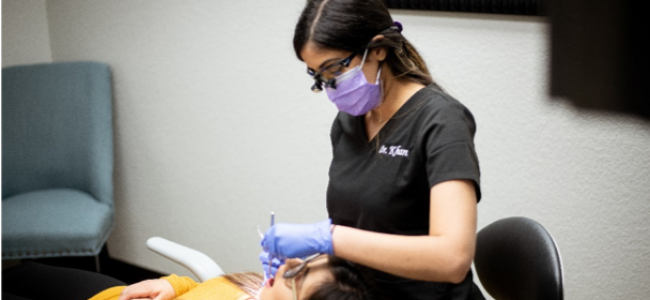Do I Really Need a Deep Cleaning?

Although an apple a day may keep the doctor away, the best way to reduce the number of dental visits each year is to brush and floss regularly. While your yearly exam should happen no matter what, you can cut down on repeat visits by keeping your teeth clean and plaque-free between visits
If you’ve been a little lackadaisical with your oral health lately, never fear! Your dentist will likely schedule you for a deep cleaning, which helps get rid of stubborn, lingering plaque under your gumline.
Many patients often wonder if a deep cleaning is really necessary, or if it’s just an arbitrary sort of procedure.
Let’s set the record straight: if your dentist has suggested a deep cleaning, it is important that you get one scheduled right away.
A deep cleaning is much more extensive than a regular cleaning, and is very effective at treating gum disease. During a regular cleaning, your hygienist or dentist will clean the front, back, and sides of your teeth as well as the gumline. In a deep cleaning, also called a “root planing and scaling,” tartar buildup is removed below the gumline down to the root of the tooth.

Healthy gums are taut, pink, and don’t bleed when they are brushed or flossed. Red, puffy gums that bleed easily when touched or brushed are the telltale signs of gingivitis. If left untreated, it can worsen to become periodontal disease. This infection of the gum and bones supporting the teeth can lead to tooth loss, which is why preventative care is so important.
Your dentist will decide whether or not you need a deep cleaning based upon x-rays or pocket depth readings taken at your regular checkup. He or she will use a small ruler, called a periodontal probe, to measure the depth of the gum pocket at the base of your tooth. Measurements of 1-3mm, with no bleeding, is considered normal and healthy. If you have pockets 4mm or greater, or other evidence of periodontal disease, a cleaning is almost always necessary to stop the progression of gingivitis.
If your dentist deems deep cleaning necessary, it is very important that you schedule an appointment. Left untreated, the pockets in your gums will continue to grow, as will the buildup of plaque and tartar and your risk of bone loss. Short of surgery, deep cleanings are the best way to reverse the negative effects of periodontal disease.
If you need a deep cleaning, this is not a rare occurrence. About half of all Americans suffer from gum disease. The fact that you are addressing the problem makes a world of difference to your future dental health. As with most health conditions, the earlier the problem is addressed and treated the better the possible outcomes are.
What Happens During the Procedure?
The phrase “root planing and scaling” refers to deposits removed from the tooth root surfaces as well as the smoothing (planing) of those surfaces, so they are resistant to tartar buildup in the future. During the procedure, your dentist will likely give you anesthesia to make the procedure easier on you. More often than not, the procedure takes place over two or three visits, and each half of the mouth is cleaned individually. Your dentist will ask you to return approximately 1 month following your deep cleaning to assess how your gums have healed/improved following the initial treatment. A future reservation will be scheduled at that time to maintain your gingival health, usually 3 or 4 months after your follow up visit. These visits will continue over time to monitor the progression of your gingival health with the set interval based upon your evaluation. In some instances of severe disease progression, a recommendation to see a periodontist (a dentist who specializes in treating gum disease) could be recommended.
If you’re still hesitant to schedule your appointment, keep in mind that gum disease doesn’t just affect your mouth. More and more frequently, studies have shown that the progression of gum disease can also be linked to an increased risk of heart disease, diabetes, dementia, and other serious illnesses. If any other part of your body was red, inflamed, or bled when you touched it, you would likely schedule a visit with your doctor immediately! Why should your gums be any different?
Some more peace of mind: insurance companies have a set of guidelines that define periodontitis and the need for deep cleaning. This means that your insurance company will usually only pay for the procedure if your dentist is able to prove that it is medically necessary. If need be, you can always get a second opinion before you make the choice to go through with the procedure.
